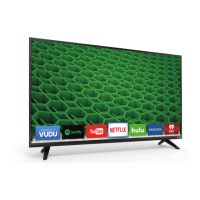
Do you have a question about the Vizio D40-D1 and is the answer not in the manual?
| Screen shape | Flat |
|---|---|
| Response time | - ms |
| Display diagonal | 39.5 \ |
| Display brightness | - cd/m² |
| Display technology | LED |
| Native aspect ratio | 16:9 |
| Native refresh rate | 60 Hz |
| LED backlighting type | Full-Array |
| Supported video modes | 1080p |
| Contrast ratio (dynamic) | 200000:1 |
| Display number of colors | 16.78 million colors |
| Viewing angle, horizontal | 176 ° |
| Motion interpolation technology | - |
| Number of OSD languages | 3 |
| On Screen Display (OSD) | Yes |
| On Screen Display (OSD) languages | ENG, ESP, FRE |
| 3D | No |
| Audio decoders | DTS |
| RMS rated power | 16 W |
| Number of speakers | 2 |
| Product color | Black |
| Panel mounting interface | 200 x 200 mm |
| DVI-D ports quantity | 0 |
| USB 2.0 ports quantity | USB 2.0 ports have a data transmission speed of 480 Mbps, and are backwards compatible with USB 1.1 ports. You can connect all kinds of peripheral devices to them. |
| Component video (YPbPr/YCbCr) in | 1 |
| Remote control type | XRT122 |
| Sustainability certificates | ENERGY STAR |
| Power consumption (standby) | 0.5 W |
| Power consumption (typical) | 36.2 W |
| Package depth | 151.89 mm |
| Package width | 1024.89 mm |
| Package height | 644.91 mm |
| Package weight | 10500 g |
| Depth (with stand) | 210.06 mm |
|---|---|
| Width (with stand) | 913.64 mm |
| Height (with stand) | 595.88 mm |
| Weight (with stand) | 8000 g |
| Depth (without stand) | 68.07 mm |
| Height (without stand) | 540.26 mm |
| Weight (without stand) | 7800 g |
Essential safety guidelines for TV operation and installation to prevent hazards.
Instructions for attaching the TV stand securely to the television.
Guidance on wall mounting the TV, including screw size and hole pattern.
General steps for connecting external devices to the TV for video output.
Instructions for connecting the TV to a home network using an Ethernet cable.
Guide to connecting the TV to a wireless network via Wi-Fi.
Step-by-step guide for the initial TV setup process, including language and country selection.
How to select and understand preset picture modes like Standard, Calibrated, Vivid, Game, and Computer.
Adjusting individual picture settings like Brightness, Contrast, Color, and Sharpness.
Advanced picture adjustments including Black Detail, Active LED Zones, Clear Action, and Noise Reduction.
How to adjust the white balance of the picture using presets like Cool, Normal, or Computer.
Creating and saving custom picture modes, locking, unlocking, and deleting them.
Process for saving customized picture settings with a custom name.
Adjusting TV Speakers, Surround Sound, Volume Leveling, Balance, Lip Sync, and Digital Audio Out settings.
Customizing audio frequencies using preset modes or creating a custom equalizer profile.
Steps to connect to a broadcasted wireless network via SSID and password.
Accessing and using parental controls to manage channel and program access.
Updating or setting a custom PIN for parental controls to prevent misuse.
Restoring the TV to its original factory default settings, erasing all changes.
Requirements for formatting and saving files onto a USB drive for playback.
Steps to connect a USB drive and play music, video, or photo files.
How to access and launch V.I.A. Plus applications from the on-screen app dock.
Accessing and navigating the fullscreen V.I.A. Plus Apps window to browse and install apps.
Explanation of the different tabs (My Apps, Featured, Latest, All Apps, Categories, Settings) in the fullscreen app window.
Steps to add applications from the app store to your personal 'My Apps' list.
Solutions for remote control problems, 'No Signal' display, and antenna signal strength.
Addressing problems related to image color, distortion, sound clarity, and basic picture settings.